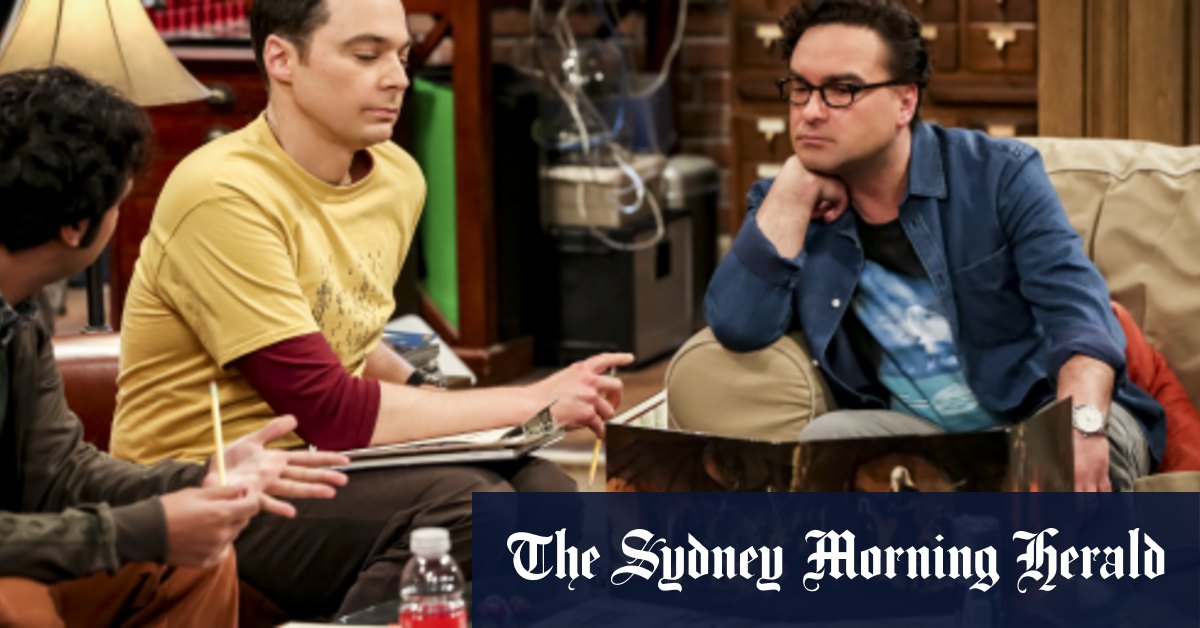
For most of its 50-year history the Dungeons & Dragons game has conjured images of nerdy boys tucked away in a basement, rolling dice, eating pizza and sending off imaginary adventurers in pursuit of orcs and trolls. And for some of those years, that description, while slightly pejorative, was not wholly inaccurate.
But five decades after it was created by Gary Gygax and Dave Arneson in Lake Geneva, Wisconsin, D&D, as it is known, is a $US15 billion ($23 billion) business for its owner, Hasbro. It has spun off a trove of toys and other products, and several feature films, the most recent of which, Dungeons & Dragons: Honour Among Thieves, pulled $US200 million at the box office in 2023.
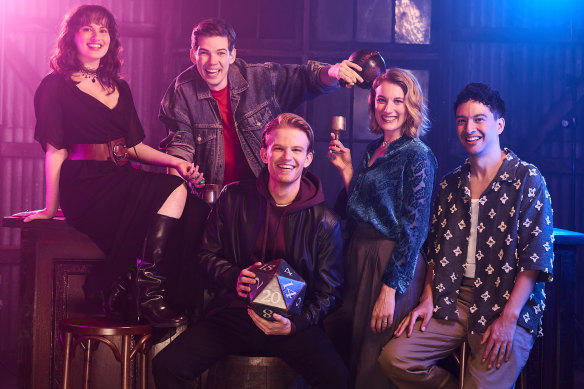
The Australian cast of The Twenty-Sided Tavern.Credit: Dan Boud
It was referenced in E.T. The Extra-Terrestrial, That ’70s Show and Community. And the Netflix hit Stranger Things draws story elements from the D&D canon, notably the monstrous Demogorgon, Mind Flayer and Vecna. It may still be a hit in the basements of the world, but upstairs D&D has gone mainstream.
Now, the game makes a transition to the stage in the form of The Twenty-Sided Tavern, a live improvisational production that uses the D&D rules – that is, its character archetypes, outcomes decided by dice roll and a moderator known as a “Dungeon Master” – as a loose framework for what transpires during the show.
Its heart, director Michael Fell says, is “putting a game on stage and involving the audience to become an active participant in the creation of a story, through the lens of the game of D&D. We call the audience the sixth performer because they actively affect the status of the game and the story that we’re telling that night.”
When the show toured the US in 2023 and 2024, reviewers were almost unilaterally positive. “The show is, to use a phrase I learned in critic school, a hoot and a half,” wrote The Workprint’s Victor Catano. “Mistakes are made, resilience and humour are at their best, and, in the most tumultuous of social times, everyone comes together, cheers together [and] laughs together,” wrote OnStage Pittsburgh’s Jessica Neu.
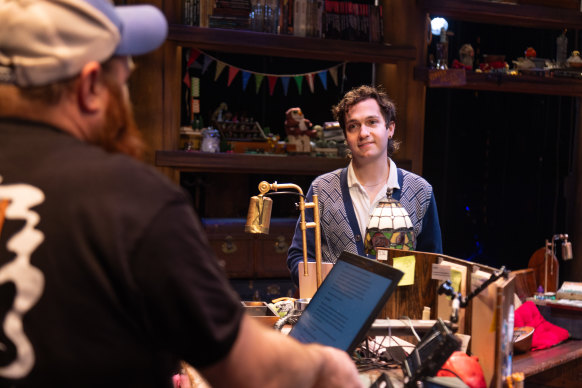
Director Michael Fell on the set of the New York production of The Twenty-Sided Tavern.Credit: Bronwen Sharp
As a director, Fell’s history as a player of the game gives him a unique understanding of how the game and the show concept intersect. “There’s a difference between improv and role-playing,” Fell says. “At first blush they seem similar, and they are similar in many ways.”
Much of the show is not scripted, Fell explains. Three of the cast members have no lines that require memorisation. “But being a D&D player and involved in table-top role-playing games (TTRPGs) for a long time, there are certain eccentricities and game moves that I teach the performers to do on stage that enhances the playing of a game,” Fell says.
“Bad things happening is the genesis of fun in D&D. When you fail a roll, that is often much more interesting than succeeding. It’s a truism in D&D and in improv and in theatre, that the kind of theatre I make is obsessed with failure. It’s so much more interesting to watch something not work.”
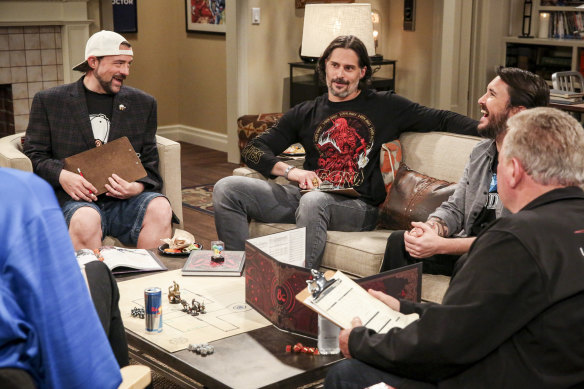
Kevin Smith, Joe Manganiello, Wil Wheaton and William Shatner play D&D on The Big Bang Theory.Credit: Warner Bros Television
Like most D&D players, Fell found the game in high school in 2000 but, in true D&D style, fumbled his first roll of the dice. “I started with some friends. We were theatre nerds in high school and my friend invited us over to his basement to play,” Fell says. “We played one session before it got completely out of control and we ended up aggravating our friend who was Dungeon Mastering for us. Fast-forward, we’d all graduated from college and we got together again and thought we should give playing D&D another try. And we were all back in.”
The game’s current edition – its 5th edition, or 5E – is the most successful in its five-decade history, in both dollar terms and also in the place it occupies in the cultural mainstream, empowered by high-profile celebrity players such as Stephen Colbert, Joe Manganiello, Wil Wheaton, Jon Favreau, Kevin Smith and Mike Myers.
The Twenty-Sided Tavern is a relatively new part of the game’s evolution, first performed at the Philadelphia Fringe Festival in 2021 and opening off-Broadway in May 2024. Its earliest iteration was unlicensed, and was unable to tap into the game’s cultural and geographical references. A recent deal with Hasbro means the script, such as it is, is peppered with namechecks like Waterdeep, Baldur’s Gate and the Sword Coast.
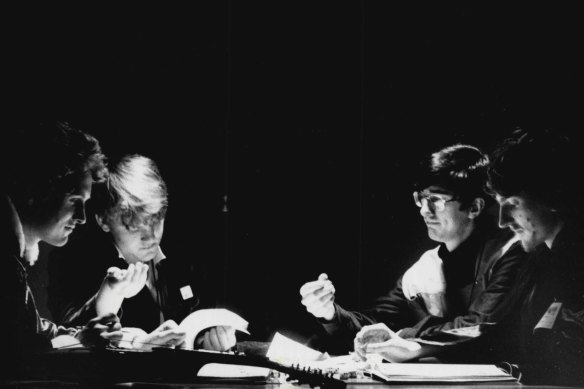
The way we were … Australian teens play Dungeons & Dragons in 1985.Credit: Bruce Milton Miller/Fairfax Media
Critically, Fell says, you don’t need to know D&D to watch the show. But it is equally true that the show taps into a subculture of in-game lore: everything from beholders, mind flayers, elves and halflings, Magic Missile and Fireball spells, to +2 long swords and potions of healing.
Midway through its 2023 tour of the US the show came to Chicago and its 549-seat Broadway Playhouse. Sitting in the audience was Heidi Gygax, the daughter of the game’s co-creator, and her husband, Erik Garland.
“We thought it was fun,” Gygax says of the show. Her father, revered by longtime fans of the game, was a great storyteller, she recalls, building stories out of elements his children Ernie, Elise, Heidi, Cindy and Luke would give him. “That was just normal for us, but now, when I think about it, I realise it’s really wonderful,” she says.
The capsule history of the game runs something like this: in August 1969 Gary Gygax meets gamer Dave Arneson and gives him a copy of his war game Chainmail. In 1971 Arneson creates a fantasy game, Blackmoor. And in 1974 Dungeons & Dragons, the literary stepchild of the two games, is unveiled.
It is an immediate hit, at least in the Gygax house, where the characters of family and friends would go on to become iconic in the game’s canon: the wizards Tenser (Gygax’s son Ernie), Melf (Gygax’s son Luke), and Gary Gygax’s own characters, the wizards Bigby and Mordenkainen, among them. Heidi’s character Murfles, a half-elf fighter/thief, never reached the fame of Tenser or Melf, but Heidi herself is immortalised on the map of the imaginary world Greyhawk, as the County of Idee.
The D&D game itself is played around a table, where the players work through a scenario moderated by the Dungeon Master, with outcomes determined by sheer wit and rolls of six “polyhedral” dice, based on the five mathematical Platonic solids (a four-sided tetrahedron, a six-sided cube, an eight-sided octahedron, a 12-sided dodecahedron and a 20-sided icosahedron) and their step-sibling, the 10-sided decahedron.
D&D’s “original” rules set is followed by a more complex iteration, Advanced Dungeons & Dragons, or AD&D, referred to in hindsight as 1st Edition, or 1E. From there the game spins in a number of directions: a simplified Basic D&D game with its own product line, and a 2nd edition of AD&D.
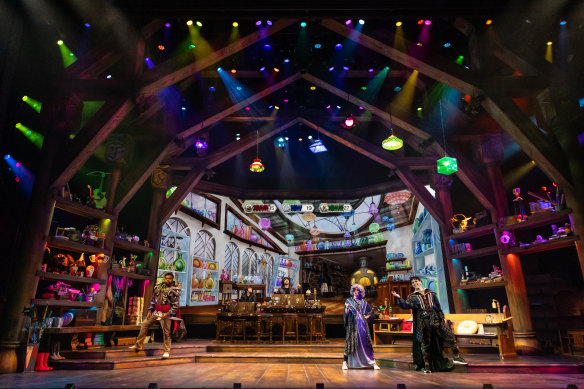
The Twenty-Sided Tavern.Credit: Bronwen Sharp
At the same time, role-playing games explode in the publishing world. They run the gamut of genres, sending players into space (Traveller, Space Opera, Metamorphosis Alpha and Star Frontiers), into the world of espionage (Top Secret), the wild west (Boot Hill) and, of course, other fantasy worlds (Call of Cthulhu, Tunnels & Trolls, HackMaster) and so on. Games tied to blue-chip IP, such as Star Trek, Doctor Who, Star Wars and the DC and Marvel universes, follow.
As a kid growing up in the Gygax household, Heidi did not grasp the game’s success until 1979, when the family moved into a bigger house. “We weren’t well-to-do when I was growing up, but what was different about our family was the types of conversations we had,” she says. “We always had family dinners, and different people would come over and play games and tell stories. We didn’t have money but we still had a lot of rich experiences.”
So, some housekeeping. Does Heidi still play D&D? There are no wrong answers here, I assure her. “I went a long time when I didn’t because I was busy, I was a single mom raising my son,” she says. But, now remarried, she is stepping back into the D&D world, developing content for the game with her husband, Erik Garland.
Her preferred edition of the game? (So-called “Edition Wars” – where fans of the various editions argue online about which is best – are a popular pastime on social media.) “I would say AD&D because that’s what I played with my dad,” she says. “5E gives so much power to the players, it doesn’t have that same feel as when we always afraid [of dying].”
The D&D game reached a cultural high point in the 1980s, featured (though not named) in the film E.T. The Extra Terrestrial. At the same time “Satanic panic” took hold in the American heartland, fuelled by two teen suicides and the popularity of horror movies. Conservatives accused D&D of promoting “demonology, witchcraft, voodoo, blasphemy [and] satanic-type rituals”. It’s never easy being a nerd.
The modern rebirth of D&D came in 1997 when Wizards of the Coast, a subsidiary of Hasbro, bought the game. A third, fourth and fifth edition followed, the last of which was updated and re-released this year. It is safer – “race” is now “species”, and culturally insensitive language and the idea that certain species are “innately” evil have been excised. Some of it seems like capitulation; some of it reflects the game’s new, young audience.
But the game endures, both as a form of entertainment and a means of human-to-human contact because built into the concept is “a sense of community, [and also] there’s a rejection of interface, where we can sit at the table and be with each other,” Fell says.
Loading
The game also offers a unique opportunity to gamers who are exploring their own identities. “As a queer person you’re able to explore identity in a way that is hyper-specific and personal to you. [The game] allows you to specifically and dynamically craft environments and people and interactions that you can test or explore.”
If he were still alive, Gygax hopes her father would take pride that the game has flourished in the mainstream. “I think he would be proud and enjoy it,” she says. “He really liked just having fun and playing games. He liked to sit down and sign autographs and meet people.”
Most meaningful, she says, are interactions with game players who have shared stories about the manner in which the game has shaped their lives. “That they’ve made their lifelong friends playing, they’d met their partner, or [that D&D had helped them when] they were at a point where they didn’t see that they really wanted to go on,” Gygax says. “That was really touching, and it expanded my view of the legacy my father left behind.”
The Twenty-Sided Tavern runs from December 15 to March 8 at the Sydney Opera House.



